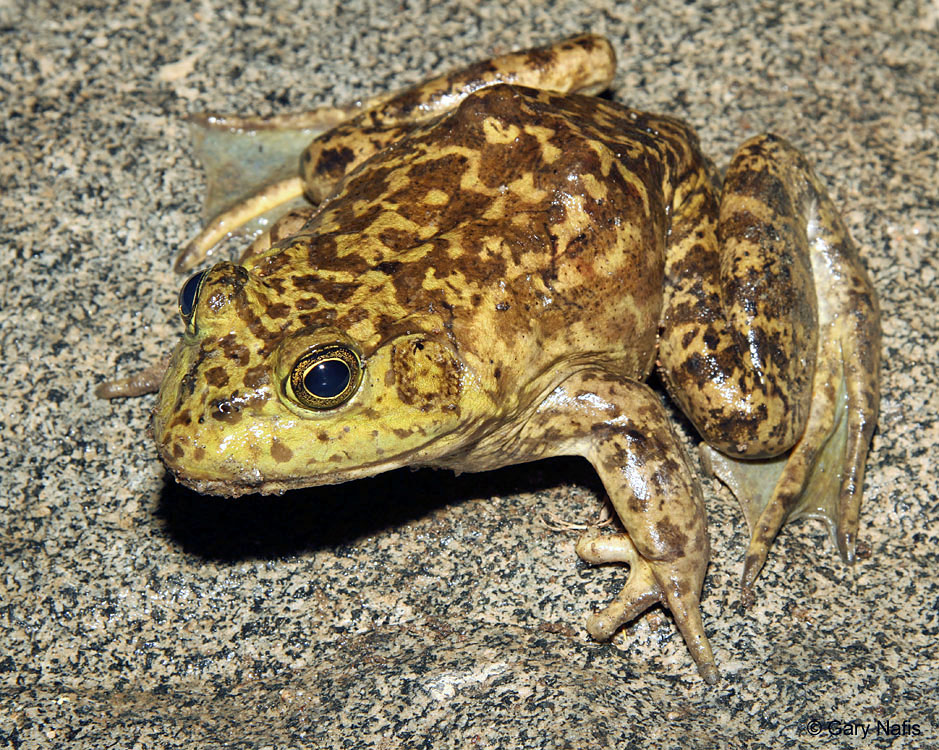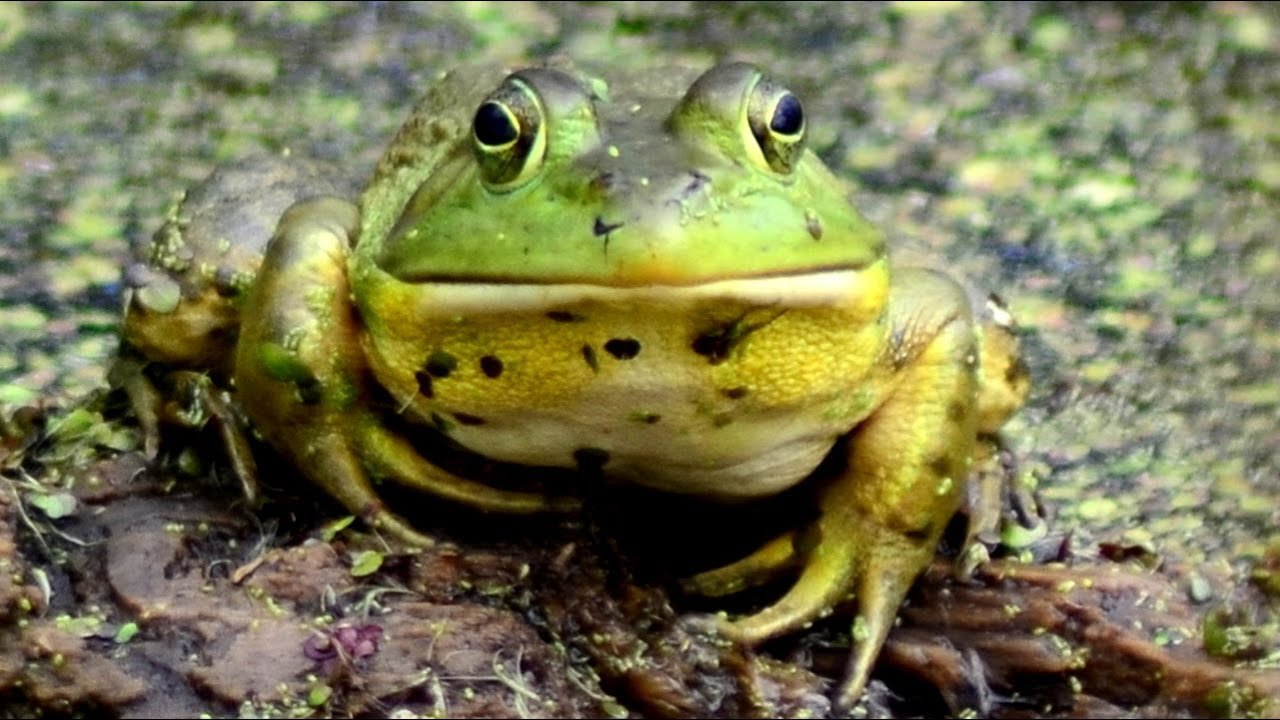A bullfrog sounds like a deep, low “jug-o-rum” or “rum-hum” noise. Bullfrogs are known for their distinctive and loud calls that can be heard in the evenings and at night near bodies of water, such as ponds or lakes.
Their call is a combination of a deep “jug-o-rum” or “rum-hum” noise, similar to the sound made when blowing across the mouth of a bottle. This unique sound is created by the male bullfrog to attract females and establish their territory.
It is a powerful and resonating call that can carry over long distances. We will explore the fascinating world of bullfrog sounds, their purpose, and how they contribute to the natural ecosystem.
Types Of Bullfrog Calls
Advertisement calls
Bullfrogs produce a distinct sound known as an advertisement call. These calls are usually made by male bullfrogs in order to attract females. The advertisement calls are loud and repetitive, often described as a deep, resonating “jug-o-rum” or “jug-o-rum, jug-o-rum”. These calls can be heard during the breeding season, which typically occurs in late spring and summer.
Territorial calls
Bullfrogs also use territorial calls to communicate with other bullfrogs. These calls serve to establish and defend their territory. The territorial calls are shorter and less repetitive compared to advertisement calls. They are often described as a sharp, metallic or “chuckling” sound.
Mating calls
When a male bullfrog encounters a receptive female, it produces a unique mating call. These calls are different from advertisement and territorial calls and are specific to the mating process. The mating calls are a series of short, pulsating notes or trills. The purpose of these calls is to court and attract the female for mating.
Listening To Bullfrog Sounds
Bullfrogs are known for their distinctive and resonant calls, often described as deep, bass-like croaks. If you’re interested in hearing these fascinating amphibians, there are a few factors to consider.
Ideal locations to hear bullfrog calls |
|
Wetlands: Bullfrogs inhabit various wetland habitats such as ponds, lakes, marshes, and slow-moving rivers. These areas provide the necessary water sources for breeding and ample food supply. |
|
Vegetation cover: Look for places with dense vegetation along the water’s edge. Bullfrogs often take shelter among aquatic plants and emergent vegetation, using them as a vantage point to call. |
|
Proximity to standing water: These amphibians prefer areas near permanent or semi-permanent water bodies. The presence of water is crucial for their survival and reproduction. |
| Best times to hear bullfrog calls |
| Spring and summer: Bullfrog breeding season occurs during these seasons, typically from April to August. Male bullfrogs actively call to attract females and establish territories. |
| Factors that influence bullfrog call activity: |
| Temperature: Bullfrogs are more active and vocal in warm weather, particularly during the evening and nighttime when temperatures are milder. |
| Water quality: Bullfrog populations thrive in favorable conditions, including optimal water quality. Clear water with abundant oxygen and minimal pollution supports their health and vocal activities. |
| Competition and territory: Bullfrogs tend to call more frequently and loudly in areas where there is competition for mates or during territorial disputes with neighboring males. |
Fun Facts About Bullfrog Sounds
The bullfrog call is a distinct sound that is often associated with wetland habitats. These vocalizations serve multiple purposes, including attracting mates and establishing territory. The call of the bullfrog is a deep, resonating sound that is produced by males during the breeding season.
Bullfrog calls have also made their mark in pop culture and media. They are often used in movies, TV shows, and commercials to create a sense of ambiance in outdoor scenes. The unique sound of the bullfrog call is instantly recognizable and is frequently associated with the tranquility of nature.
Interestingly, the bullfrog call has different interpretations in various cultures. In some cultures, it is believed that the bullfrog call is a sign of good luck and prosperity. In others, it is seen as a symbol of transformation and rebirth. These interpretations add a cultural dimension to the significance of bullfrog calls.
Understanding The Bullfrog Call
Bullfrogs produce a unique and unmistakable call that is key to their survival and communication. These amphibians, typically found near bodies of water, have loud, resonant calls that can be heard over long distances. The importance of bullfrog calls lies in their ability to attract mates, defend territory, and delineate their presence to other frogs.
Significance Of Bullfrog Calls In Communication
Bullfrog calls are a vital part of their communication system. Every individual bullfrog has its distinct vocalization, allowing other frogs to identify individuals and determine their location. Males use their calls to attract females during mating season. The loudness, duration, and frequency of the call convey information about the male’s fitness and quality as a potential partner.
Evolutionary Purpose Of Bullfrog Calls
The evolution of bullfrog calls can be traced back to the pressure of natural selection. By producing distinct calls, bullfrogs are able to compete with other males for mates and establish their dominance in the breeding area. Over time, the calls have evolved to become more effective in attracting females, ensuring successful reproduction and passing on desirable traits to the next generation. This evolutionary process has led to the development of unique and species-specific bullfrog calls.
Characteristics Of Bullfrog Calls
The bullfrog is known for its deep and resonant croak. This distinct call can be heard in various habitats across North America. The pulsating and rhythmic nature of the bullfrog’s call is what sets it apart from other amphibians. These calls are produced by the male bullfrogs during the mating season, as a way to attract females and defend their territory.
Each bullfrog has its own unique call, with distinctive patterns that can be used to identify individuals. The call of a bullfrog consists of a series of short and long notes, often repeated in a specific pattern. This pattern can vary depending on factors such as temperature, humidity, and the individual frog’s physical condition.
The bullfrog’s call is a biological marvel, allowing these amphibians to communicate over long distances and play a crucial role in their reproductive success. So, next time you’re near a pond or wetland, listen carefully for the deep and resonant croak of the bullfrog.

Credit: californiaherps.com
Quick Facts About Bullfrog Sounds
Bullfrogs are well-known for their deep and distinctive calls. Their calls are a prominent feature of warm summer nights near bodies of water. These calls serve several purposes, including attracting mates and establishing territory.
Frequency and volume of bullfrog calls:
Bullfrog calls are characterized by their low frequency and loud volume. The calls can range from 100 to 750 Hertz, making them easily distinguishable. The volume of the calls can be quite impressive, reaching up to 90 dB.
Variations in bullfrog calls:
While the general pattern of bullfrog calls remains the same, there are variations in the sequence and timing of the calls. These variations may be influenced by factors such as temperature, humidity, and the presence of other bullfrogs.
Sound production mechanism in bullfrogs:
Bullfrogs produce their calls by forcing air from their lungs through their vocal sacs, which then amplifies the sound. The vocal sacs act as resonating chambers, allowing the calls to carry over long distances.
Conservation Implications Of Bullfrog Sounds
Bullfrog calls can provide valuable information for monitoring and conserving their populations. Researchers have conducted extensive studies on bullfrog calls to understand their behavior patterns and use them as a tool in conservation efforts.
One major application of bullfrog call monitoring is in tracking population densities. By analyzing the frequency and intensity of calls, scientists can estimate the number of individuals present in a given area. This information is crucial for assessing the health of bullfrog populations and identifying areas where conservation efforts should be focused.
Another important aspect of studying bullfrog calls is understanding how environmental changes impact their call behavior. Changes in temperature, habitat loss, and pollution can alter the acoustic characteristics of bullfrog calls. By monitoring these changes, scientists can gain insights into the health of ecosystems and potential threats to bullfrog populations.
Overall, research on bullfrog calls provides valuable data for conservation efforts. By understanding their call behavior, scientists can develop strategies to protect and restore bullfrog populations, thus preserving their ecological importance.
What Does The Bullfrog Say?
A bullfrog says “Heigh-ho” when hatching from its egg. A bullfrog can also talk when they are mating. As a male, a bullfrog can make a “jug-o-rum” sound. He can also say “I’m a bullfrog. I’m a bullfrog. I’m a bullfrog.” Other times a bullfrog says “My name is Shubb-dub. Shubb-dub.” This is when a bullfrog is calling a female.
There are lots of other sounds a bullfrog can make. If you get a chance to hear one, you should take the time to learn all about this amazing amphibian. Here’s something else you should know:
Why Does A Bullfrog Croak?
A bullfrog croaks because it wants to attract a mate. A bullfrog croaks to attract females of its own kind. A bullfrog also croaks to attract males. This is so that it can attract male bullfrogs.
The bullfrog is a frog of the family Ranidae, order Anura, and genus Rana. The family Ranidae is composed of small to medium-sized frogs. It contains about 1,100 species.
Why Do Bull Frogs Croak At Night?
A bullfrog croaks at night to call females to its habitat. A bullfrog also croaks at night to attract males to its habitat. This is so that it can mate with the males.
This frog also croaks during the day. It does this to tell other frogs where their habitat is located. A scientist was doing fieldwork in a jungle in South America. He was wearing a white shirt, dark pants and he carried a white plastic bag.
How Do You Know A Bullfrog Is Calling A Female Bullfrog?
A bullfrog’s croaking and mating calls can be used to make a rough estimate of the bullfrog’s age. A bullfrog can be about four to five feet long. A bullfrog is a large frog that is between 6 and 8 inches long. The bullfrog is a frog that has a yellowish-brown on its back and sides.
It has a black stripe going across its back and a bright red throat. A young male will have an orange throat. This turns to a reddish-orange as the male matures. A mature bullfrog will always have a bright, vivid red throat. This allows you to tell the difference between a young and an old bullfrog.
Frequently Asked Questions Of What Does A Bullfrog Sound Like
What Kind Of Noise Do Bullfrogs Make?
Bullfrogs make a deep, resonant sound called a “croak. ” The croak is distinctive and can be heard over long distances.
What Does It Mean When You Hear A Bullfrog?
When you hear a bullfrog, it means you’re listening to the unique croaking sound made by this amphibian.
How Far Away Can You Hear A Bullfrog?
You can hear a bullfrog up to one mile away.
How Do You Tell If A Frog Is A Bullfrog?
To identify a bullfrog, look for its distinctive deep croak, large size, and green or brown coloration. Bullfrogs also have longer hind legs and webbed feet, which they use for swimming. Their eardrums are bigger than their eyes, while in other frogs, the eyes are larger.
Conclusion
To sum it up, the distinctive sound of a bullfrog can be likened to a deep, resonant bellow that echoes across ponds and marshes. This unmistakable call serves as their way of communication during mating season, attracting potential partners from afar.
By understanding this unique sound, we can appreciate the beauty and diversity of the natural world around us. Listen closely, and you may just hear the enchanting chorus of bullfrogs in nature’s symphony.
